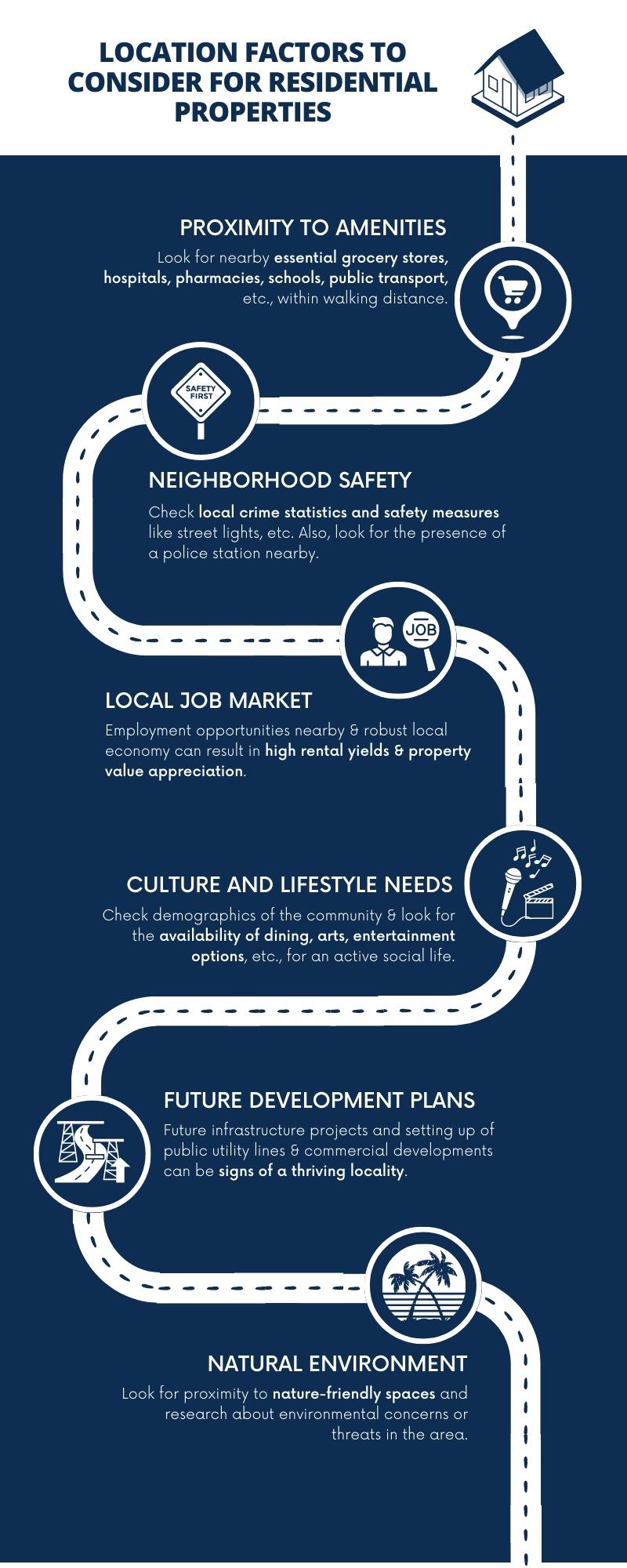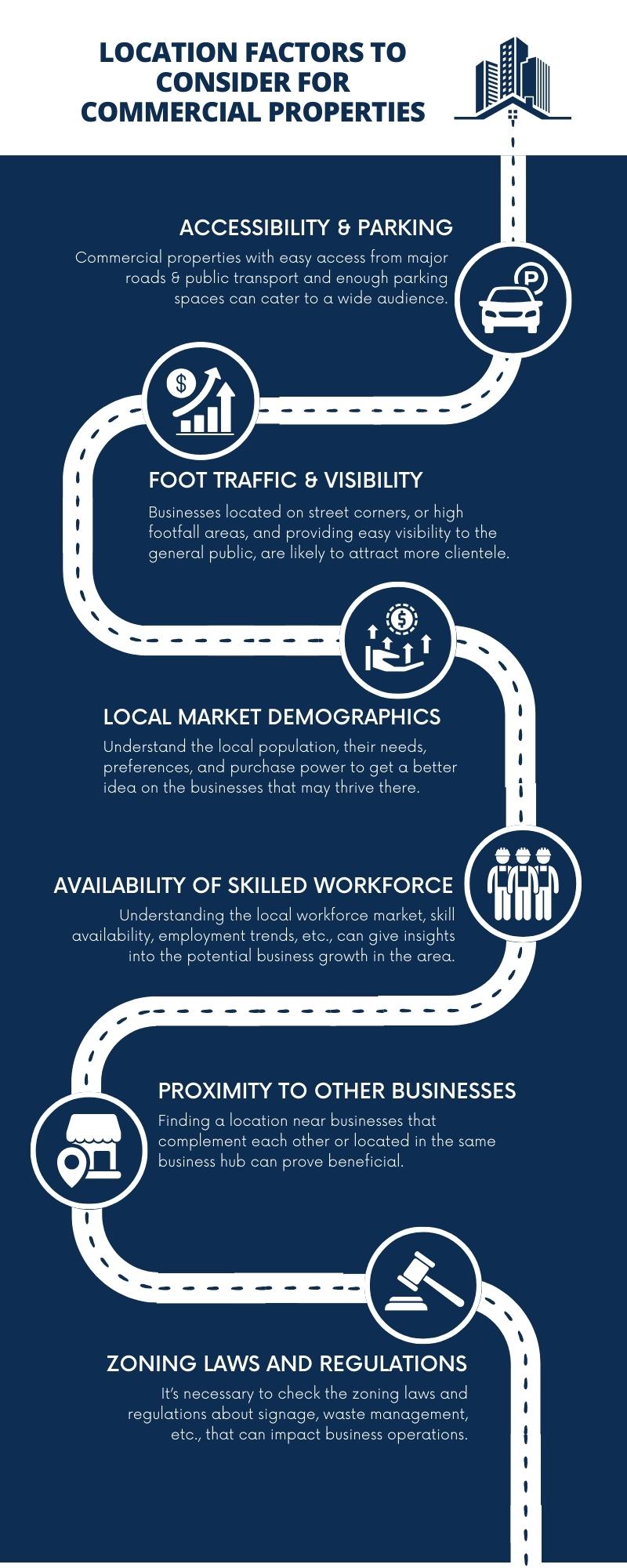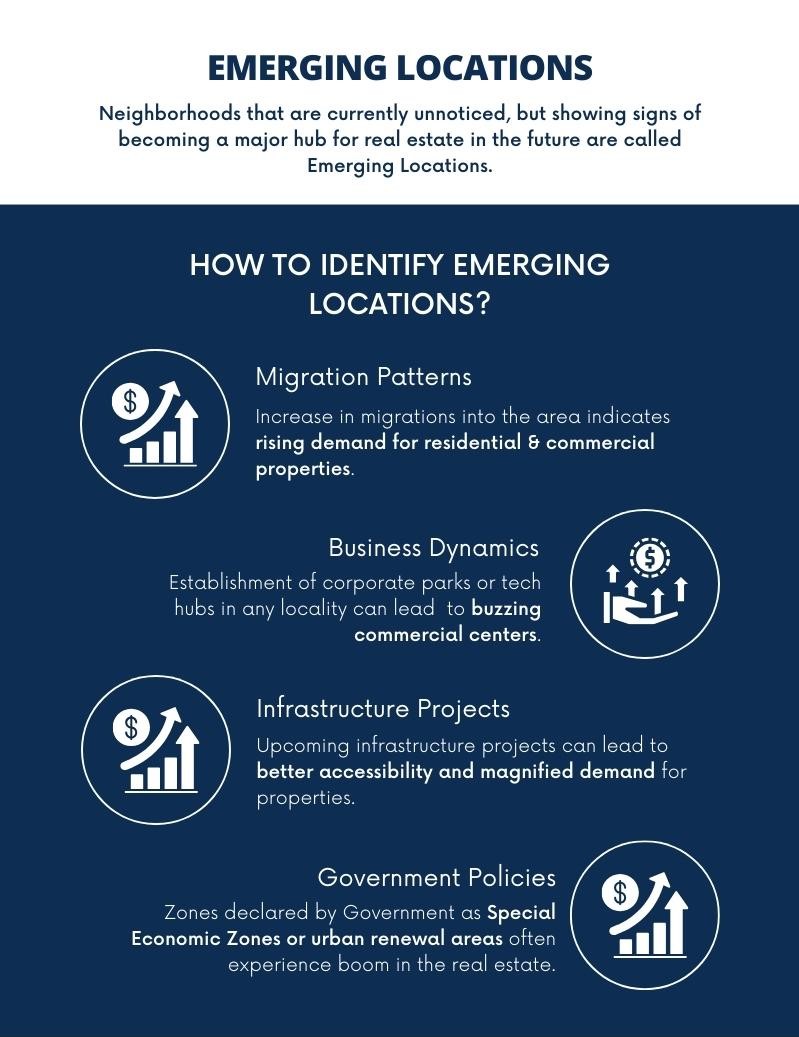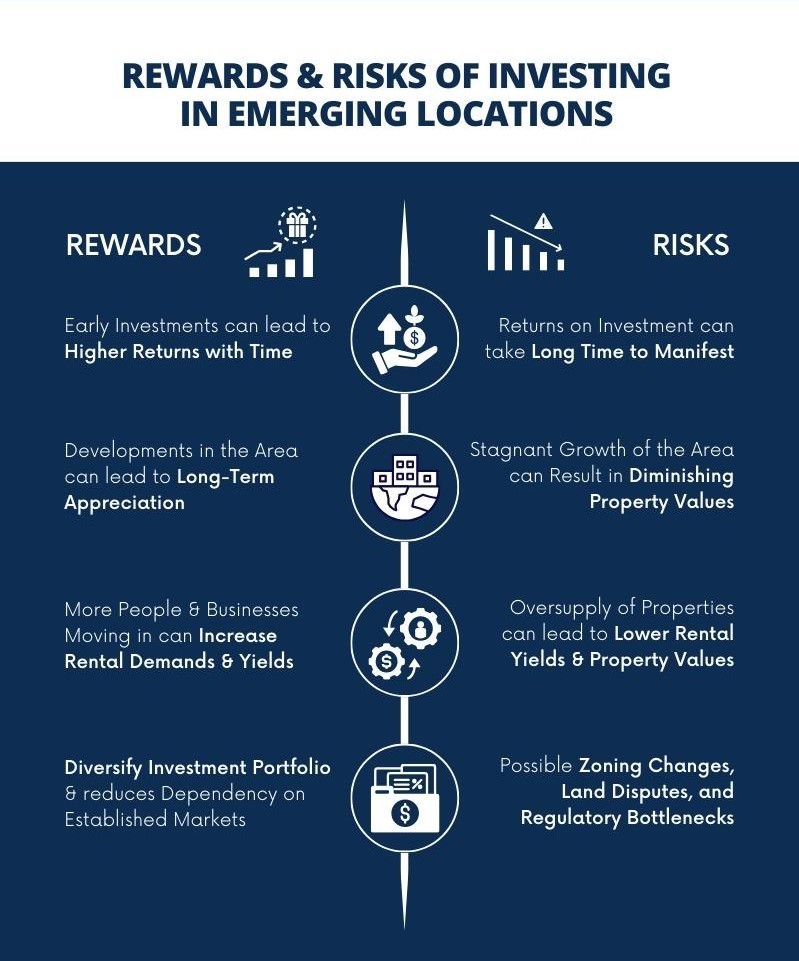Importance of Location in Real Estate: Key Factors to Consider when Investing

“Location, location, location!” When it comes to real estate, this age-old saying isn’t just a catchy phrase—it encapsulates the very essence of property investment.
It cannot be said enough that location of a property is of paramount significance in the real estate domain. Even when a building’s age and designs may become old, a prime location will always remain in demand (forever).
Opting for the right location can yield higher returns, provide consistent rental income, minimize vacancies, and even buffer against potential market downturns.
Irrespective of whether you are investing in a residential property or a commercial one, the surroundings, proximity to essential amenities, safety and vibe of the neighborhood, potential future developments in the area, natural environment and scenic views, and the current and forecasted economic health of the locality are all essential factors that play a pivotal role in determining the true value of a property, potential for its appreciation, and overall attractiveness to both homeowners and renters.
Read on to get the complete info on the key location factors you must consider, how to determine the price trends in a locality, what are emerging locations and the risks & rewards of investing there, and some simple case studies to easily understand how location can either make or break your investment.
Also Read: What are the Benefits of Investing in Real Estate?
Table of Contents
- Key Location Factors for Residential Properties
- Key Location Factors for Commercial Properties
- What are 'Emerging Locations'?
- How to Determine Price Trends in a Locality?
- Case Studies of Successful & Failed Investments due to Location
Key Location Factors for Residential Properties
Residential properties are not just building structures; they are the backdrop against which people’s lives unfold. They encompass a broad spectrum of property types that includes single-family homes, apartments, condominiums, townhouses, villas, and more.
When purchasing a new home or investing in residential properties, the selection of a suitable locality can make a world of difference not just in terms of financial returns but also in the quality of daily life.

Here’s an in-depth look at the crucial location factors you should consider for residential properties:
#1 Proximity to Amenities
-
Schools, hospitals, shopping centers, recreational areas: A home near well-rated schools can not only support a child's education but also significantly uplift the property's value. Similarly, having hospitals, shopping centers, and recreational areas nearby ensures that daily necessities and leisure activities are within easy reach. For instance, a condo located a stone's throw away from a bustling shopping plaza or a park might be more appealing to families.
-
Public transportation: Proximity to public transportation can be a game-changer, especially in metropolitan areas. Homes near bus stops or metro stations ensure residents can commute with ease, saving both time and commuting expenses.
#2 Neighborhood Safety and Security
-
Crime rates and safety measures: It’s a good idea for potential homeowners to often check local crime statistics before purchasing a property. A neighborhood with low crime rates and effective safety measures such as neighborhood watches or well-lit streets can be a secure purchase for long-term.
-
Presence of local law enforcement: Look for the presence of local law enforcement agencies like a nearby police station, and check the accessibility to them, to get an added layer of assurance.
#3 Local Job Market
-
Employment opportunities nearby: Residential areas near business districts or tech parks can attract working professionals looking for minimal commute times, which can in turn result in consistent and high rental yields.
-
Economic stability of the region: A robust local economy can ensure consistent property value appreciation. Localities having diverse industries can offer more stability than those reliant on a single industry.
#4 Cultural and Lifestyle Alignment:
-
Social scenes, dining, arts, and entertainment: For many, life isn’t complete without a vibrant cultural scene. Localities rich in cafes, theaters, galleries, and entertainment venues can be a magnet for those seeking an active social life.
-
Demographics and community culture: Being in a community that aligns with one’s lifestyle and values can enhance life satisfaction. For instance, a young family might prefer a neighborhood with other young families, parks, and schools, while retirees might lean towards quieter communities with senior facilities.
#5 Future Development Plans in the Area
-
Planned infrastructure projects: Future projects like highway extensions, new roads, or public utilities can influence property values. For example, a new highway or metro station can provide better accessibility, potentially increasing the value of homes in that area.
-
Upcoming community or commercial developments: Planned shopping malls, parks, or cultural centers can make a locality more attractive. An upcoming sports complex or community center can be a sign of a thriving community.
#6 Natural Environment of the Locality
-
Proximity to parks, lakes, beaches, or mountains: Homes overlooking natural sceneries like a serene lake or a lush park can offer residents daily respite from urban chaos. These properties not only offer a unique living experience but often fetch higher values in the long run.
-
Environmental concerns or threats: On the flip side, properties in flood zones or areas prone to natural calamities might come at a lower cost but carry long-term risks and higher insurance costs.
In sum, while the structure of a home is undeniably important, it's the surroundings that truly shape the living experience. As such, considering these location factors is paramount for both homeowners and investors.
Also Read: What to Ask Your Real Estate Agent before Buying a New Home
Key Location Factors for Commercial Properties
Commercial properties serve as the bedrock for businesses, fostering economic growth and facilitating numerous commercial activities. These properties range from retail spaces, offices, warehouses, industrial sites, to mixed-use buildings that may combine retail, office, and residential spaces.
When investing in commercial properties, it's not just about the structure or the price. The locality and its dynamics can heavily influence the success or failure of a business operating there.

Here are the vital location factors that can influence the value and desirability of commercial properties:
#1 Accessibility
-
Ease of transport (major roads, public transport links): A commercial property that's easily accessible via major roads or public transport can cater to a wider audience. For instance, an office building near a metro station can be a huge draw for companies as it aids employees in their daily commute.
-
Availability of parking: In urban settings, parking can be a premium. Retail spaces or offices with ample parking facilities can have a competitive edge, ensuring convenience for customers and staff alike.
#2 Foot Traffic & Visibility
-
Busy streets and intersections: For retail businesses, being situated in high footfall areas can directly translate to higher sales. A cafe, shopping mall, or boutique on a bustling street corner can naturally attract more clientele.
-
Visibility to the general public: Properties that are easily noticeable, perhaps due to their exterior designs or strategic positioning, can garner more interest in customers. A storefront with large, attractive displays on a main road can gather more paying customers.
#3 Local Market Demographics
-
Target market analysis: Understanding the local population, their needs, preferences, and habits can provide insights on the type of business that might thrive. A high-end boutique might do exceptionally well in upscale neighborhoods.
-
Consumer purchasing power and behavior: Areas with higher disposable incomes might support luxury offerings, while budget businesses might thrive in more densely populated, middle-income regions.
#4 Availability of Skilled Workforce
-
Nearby educational institutions: Commercial properties near universities or training institutions can be lucrative, especially if the business requires specialized skills. Tech startups might flourish near engineering colleges, while design firms might prefer being close to art schools.
-
Labor market dynamics: Understanding the local labor market, including wage levels, skill availability, and employment trends, can help investors gauge the sustainability and potential growth of businesses that might operate in the area.
#5 Proximity to Other Businesses
-
Complementary businesses: Locating near businesses that complement rather than compete can boost client patronage. For instance, a printing shop near a corporate office complex or a gym next to a health food store.
-
Competing businesses: While competition can be tough, being in a business hub, say a tech park or a shopping street, can also mean that the area is a recognized go-to spot for certain services or products.
#6 Zoning Laws and Regulatory Environment
-
Permitted uses of the property: Every commercial space comes with zoning regulations. A property might be zoned for retail but not for a restaurant. It's essential to ensure that the intended use aligns with the zoning laws.
-
Potential regulatory hurdles: Some areas might have stringent regulations regarding signage, waste management, or building modifications. These can impact business operations and should be considered before investing.
To wrap up, commercial properties, though driven by profitability, are deeply intertwined with their surroundings. For investors, considering these location-specific nuances can make all the difference between a thriving commercial endeavor and a bland one.
Also Read: Important Vastu Tips to Set Up Your Office Space for Success
What are 'Emerging Locations'?
Of late, 'Emerging Locations' is the buzzword that has been creating ripples in the investment community.

Emerging locations refer to areas or neighborhoods that are currently unnoticed by the mainstream real estate investors but are showing strong signs of becoming major hubs in the near future.
Often, emerging locations offer cost-effective real estate options compared to overpriced central zones. Investors can gain significantly if they spot this potential early on.
Emerging locales could be areas undergoing infrastructural development, attracting new businesses, or benefiting from governmental policies.
Examples could include places like the outskirts of major cities, such as Bangalore's growth trajectory in the 90s and early 2000s (important localities like Electronic City, Whitefield, Sarjapur Road, etc.), when the IT boom transformed overlooked regions to prime real estate hubs.
How to Identify Emerging Locations?
- Migration Patterns: An influx of population into a particular locality, be it for employment or education, can signal a rising demand for both residential and commercial spaces.
- Business Dynamics: The establishment of corporate parks, factories, or tech hubs can convert sleepy towns into buzzing commercial centers where smaller retail businesses can also start establishments here.
- Infrastructure Projects: Keep an eye out for upcoming major infrastructure endeavors like highways, airports, or metro stations. Such projects can lead to increased accessibility and subsequently magnified demand.
- Government Policies and Initiatives: Zones declared by the government as special economic zones or areas receiving grants for urban renewal often experience a real estate boom.
Also Read: How to Evaluate the Market Value of a Property
Risks and Rewards of Investing in Emerging Locations

Rewards:
- Higher Returns: Early investment in these areas can yield substantial returns as property values can be quite low at the time of investment and can surge with time.
- Diverse Portfolio: Investing in emerging zones can diversify one's portfolio, reducing dependency on established markets.
- Long-Term Appreciation: As the area develops and matures, long-term appreciation in property value is often observed.
- Rental Yield: Especially for commercial properties, as businesses move in, rental demands and thus yields often increase.
Risks:
- Uncertainty: Predictions about an area's growth might not always materialize, leading to stagnant or even diminishing property values.
- Time Horizon: Such investments are often long-term plays. Immediate returns might not be on the cards.
- Regulatory Hurdles: Emerging zones might face zoning changes, land disputes, or regulatory bottlenecks.
- Oversupply: If too many developers get involved, the area might face an oversupply of properties, leading to reduced rental yields and property values.
Also Read: What are the Factors that Influence Rental Rates
For both residential and commercial properties, the emerging locations game is a balance of risk and reward. While residential properties in these areas might offer living solutions to those who are priced out of central zones, commercial properties can cater to growing businesses. The key lies in thorough research and understanding the market dynamics driving the growth.
How to Determine Price Trends in a Locality?
A fusion of the past and predictions for the future, historical and forecast data provides a well-rounded perspective on the potential value and risks associated with a property.
Also Read: How to Analyse and Understand Real Estate Market Trends in India
#1 Analyzing the Past Price Trends to Understand the Present
Historical data offers a blueprint of how property prices have evolved over time in a specific area. This analysis reveals patterns, growth rates, and potential market anomalies.
How to Analyse Historical Price Trends in an Area
- Time Frame Selection: Decide on a meaningful period for analysis. While short-term data (1-5 years) can reveal recent market fluctuations, long-term data (10+ years) can offer insights into more sustained growth or decline patterns.
- Data Sources: Rely on reputable property databases, government land records, and real estate associations. Consistency in sources ensures data reliability.
- Comparative Analysis: Compare the area in question with neighbouring regions or similar property markets. This will highlight the unique selling points or red flags.
- Check Underlying Factors: Always correlate price trends with historical events or policy changes. Did a sudden price rise coincide with a new infrastructure project or a corporate boom in the area? This will help understand the potential issues in the locality.
Also Read: Is it Better to Rent a Home or Buy a Home?
#2 Forecasting Growth or Decline to Make Guided Investments
After grasping the historical context, forecast data projects the possible trajectories for property values. This will help you make informed decisions about the investment, highlight potential risks, and potential property price escalations.
How to Predict Future Trajectories of a Location
- Economic Indicators: Monitor national and regional economic health indicators. These include GDP growth rates, employment rates, inflation, and interest rates. A strong economy often indicates a potential rise in property prices, while economic downturns might signal stagnation or decline.
- Infrastructure and Development Plans: Upcoming infrastructure projects like highways, metro lines, and airports can boost property prices in their vicinity. Keep an eye on government announcements and approved development projects.
- Real Estate Supply and Demand: Understand the current supply of properties in the locality and the demand for them. An oversupply with decreased demand can lead to a price drop, while a high demand with limited supply often pushes prices up.
- Local Market Dynamics: Study factors like corporate or industry developments in the area, the arrival of major employers, or educational institutions. These can increase demand for housing and commercial spaces, leading to price appreciation.
- Regulatory Changes: Government policies can have a significant impact on real estate prices. For instance, tax benefits for first-time homebuyers or relaxation in property investment for foreign nationals can stimulate demand and push prices upward.
- External Factors: Events like natural disasters or geopolitical tensions can impact property prices. For instance, a coastal area that increasingly faces flooding might see declining property values due to environmental concerns.
- Feedback from Local Experts: Engage with local real estate agents, property managers, and other professionals. Their on-ground experience and insights can provide valuable cues about potential price trajectories.
- Data Analytics Tools: With the rise of technology, there are numerous real estate analytics platforms and tools that use complex algorithms and massive datasets to forecast property price trends. These can offer quantitative predictions to support or challenge your qualitative assessments.
In conclusion, historical and forecast data together paint a complete picture, where the past informs the present, and predictions illuminate potential paths. For investors, this acts like a compass, guiding them through the vast and often tumultuous seas of real estate investment.
Also Read: How to Verify the Legal Status of a Property
Case Studies of Successful & Failed Investments due to Location
While the right location insights can unlock exponential value, overlooking critical location dynamics can lead to prolonged stagnation and, in some cases, significant losses.
Here, we recount two stories: one, a testament to the rewards of meticulous location-based research, and the other, a cautionary tale of the perils of neglecting location dynamics.
A Success Story: The Bangalore Boom
Mr. Raghav, a seasoned investor, was always on the lookout for the next promising real estate horizon. Back in the early 2000s, while major metropolitan areas like Mumbai and Delhi already had skyrocketing property prices, Bangalore was still emerging as an IT hub. Raghav's research indicated a surge in IT companies setting up their bases in Bangalore, coupled with the government's plans to enhance the city's infrastructure.
With this foresight, Raghav invested in multiple residential and commercial properties in areas like Whitefield and Electronic City. As the IT boom enveloped Bangalore, these areas became sought-after locales. Numerous tech parks sprang up, drawing tech professionals from across the country. The demand for quality housing and commercial spaces surged.
Today, Raghav's investment has multiplied manifold. Those once affordable properties are now premium addresses, all thanks to Raghav's strategic bet on Bangalore's growth trajectory.
Also Read: What is the Process of Buying a Home in Bangalore
A Cautionary Tale: The Noida Extension Pitfall
Ms. Ananya, a first-time investor, was swayed by the promise of affordable housing schemes and rapid development in the Noida Extension area during the late 2000s. Developers were pitching grand visions of modern townships, packed with world-class amenities. The prices were a fraction of what major areas in Delhi demanded, and the promise of metro connectivity further sweetened the deal.
Without delving deep into the nuances of location-based factors, Ananya invested in a residential project there. However, soon the headlines were flooded with land acquisition disputes between developers and local farmers. Multiple projects were stalled, legal battles ensued, and the promised infrastructure developments were delayed indefinitely.
While the area did eventually see growth, it took far longer than anticipated. The delays meant Ananya's funds were locked in without any returns, and the property value appreciation was not as robust as other areas which had clearer land titles and smoother development trajectories.
The location of a property isn't just an aspect of real estate—it's often the very heart of it. All the good qualities of a location can multiply the value of an investment, while an overlooked flaw can result in unforeseen challenges and reduced returns.
It's proximity to amenities, neighborhood safety, accessibility, potential for future development, or the local job market and culture, numerous factors come into play. For those seeking residential properties, considerations like natural surroundings, schools, and hospitals take precedence. In contrast, commercial property investors might prioritize foot traffic, market demographics, and the regulatory landscape.
Do a deep research about the local market dynamics, looking into everything from supply and demand to employment opportunities and zoning laws and regulations, etc. Understand the history of a location and check the future trajectories. Evaluate the infrastructure in and around the locality and make note of development plans. Identify emerging localities which can be quite affordable and provide higher returns; however, remember to consider the potential risks of investing there.
Remember that real estate investment is as much a science as it is an art. You must do due diligence, analyze, verify, and weigh all the factors of the property in accordance to your own needs, priorities and vision for the investment. Dive deep, research thoroughly, and remember: in real estate, as in life, where you are can often define what you become. Here's to making informed, location-smart investments!











